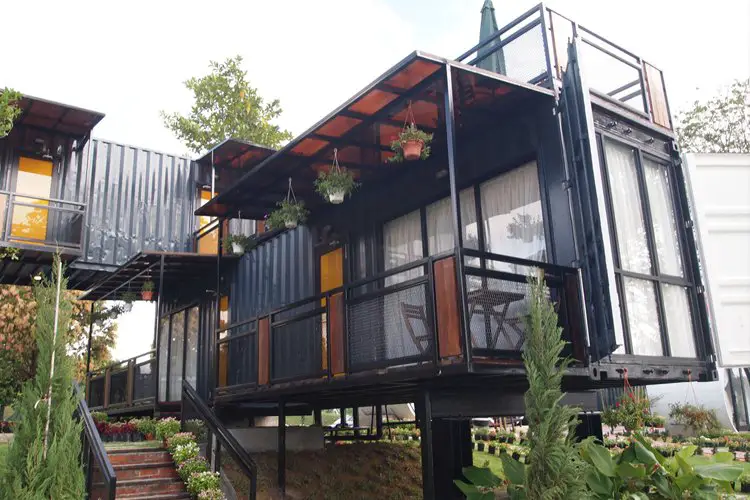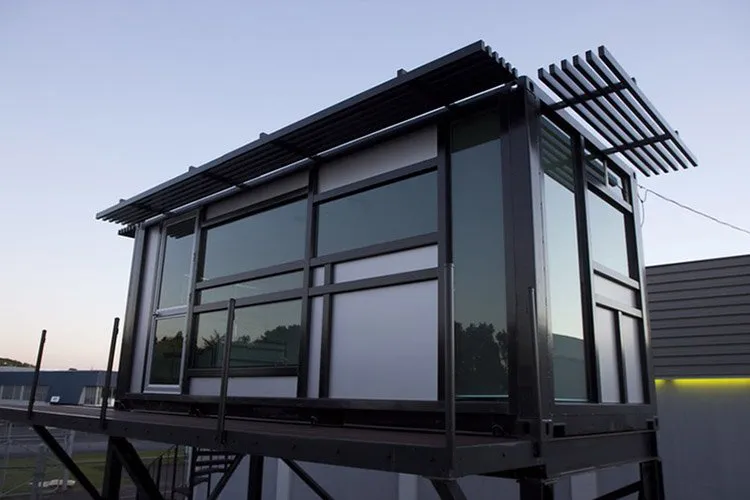In this crazy real estate market, many people are seeking alternative housing options. You may have noticed a growing trend in using shipping containers for modern homes. With the rise of the tiny home and alternative solutions to the high costs of traditional homes, container homes have become hugely popular and have been used for anything from commercial offices, bars and cafes, and even hotels and full time residences.
If you are looking for a housing solution that involves lower costs for construction and maintenance, a container house might be for you. Homes are made either from a single container or a series of containers can be joined together. They can be as simple or elegant as you wish depending on your budget and lifestyle.
Although shipping container homes present a unique and cost-effective housing solution, there are some pros and cons to consider. Here, we discuss the various advantages and disadvantages of living in a shipping container home. If plan to go for this housing solution, then this post should get you on the right track.
View this post on Instagram
Container Homes: Pros
Cost-Effective Solution
Shipping container homes are definitely cheaper than traditional homes which is in no small part of their big appeal. A used structure could be found for under $1,000. While a new structure can be found for as low as $1,500 for a 20 foot container and run up to $3,500. For a 40ft container, estimate between $2,500 and $5,000 for the structure.
Rapid Construction
With a container home, you can purchase the basic structure so you’re off to a running start on the build. But of course you’ll need to figure in the costs and time to make a container a home – which include insulation, electrical, plumbing and whatever specifications you want in your container (or set of containers). Labor will need to include cutting doors and windows as well as clearing land if necessary, landscaping, decks or other requirements.
Eco-friendly Housing Solution
Shipping containers are generally considered an environmentally conscious building since they’re already made, can be recycled and they are in large supply, particularly after the supply chain issues that came with the pandemic. Read more here about the sustainability factors to consider in these homes.

Robust Construction
Shipping containers are made from strong material that can withstand harsh weather and remain watertight. As they were made for transporting cargo on the high seas they are built to survive winds, rough water and harsh weather. Most shipping containers are made from corten steel which is also called weathered steel. Not only is strong, it has the physical properties to make it rust-resistant and weldable.
Easy Transportation
Shipping containers are designed to be transported easily from one place to another. Therefore, when it comes to transporting shipping container homes to their destination or a new destination, you can easily move them depending on how they were built. If you are considering a home that can be moved in the future, you can design your shipping container home with mobility in mind, making it relatively easy to get it on a truck to move.
Predictable Costs
The cost of a container will not vary much for a given size. Unlike traditional homes where the final cost of construction far exceeds the original budget, it is unlikely to occur with a container home. You pay a fixed price for a container or containers of a particular size. Then, based on the size of the container accurately estimate the cost of your build, furniture, fixtures, and other accessories.
View this post on Instagram
Customizable Designs
You can easily modify a shipping container home. There are different plans and layouts available. A good builder or architect will help you create an aesthetically good-looking home for you to live in.
There are different configurations where you can stack the containers to create multiple floors, cut through them to create open spaces, and put them together in multiple ways. Building a shipping container home can get as creative as your design and budget allows.
Energy-efficient Dwellings
If you plan well, your container can be fairly energy-efficient. Because of the reduced size, you will find a container home easier to heat and cool. Adding energy-efficient features like green roofing, efficient appliances, spray foam insulation, and solar panels can add to the energy efficiency of your container home.
Container Homes: Cons
Difficulty in Getting Building Permits
In many areas, the concept of container homes is still pretty new. Therefore, you might not even find rules and regulations that apply to these homes which may lead to difficulty in getting permits. However, a few states like Oregon, Colorado, California, and Texas already have building regulations for shipping container homes. Check with your local municipality on permit regulations before you get too far in your plans.
Not Always Eco-friendly
Shipping containers could have transported hazardous chemicals in their past life. The traces of such chemicals could remain in the containers. You need to exercise caution in ensuring not to buy a container contaminated with toxic chemicals.
Location Issues
You may find it difficult to find a location for installing your new container home. Even if you identify a location, you might find it inconvenient in terms of proximity to local amenities and your place of work. Since some areas do not allow container homes to be installed, they may be a better option for rural areas. Local building regulations may restrict your choice of location.
High Internal Temperature
Shipping containers are made from metal which attracts heat. During hot summer days, the internal atmosphere of a shipping container can become like an oven. Even with thick insulation, you may need to keep your air conditioner running all day to maintain a cool temperature during the summer. The added insulation may also eat up the already limited space within your container home.
Recycling is Not Always Effective
A fact about shipping containers is that most of them are made for single use. It means that most of the containers may have served their purpose to transport goods in a single trip.
Even if they were used multiple times, they are now discarded because they are no longer useful for their original purpose. Due to this, you might find a variety of defects in the container for your new home so check the condition of the shipping container carefully.
Structural Issues
The corners of a shipping container are strong but you may have to add reinforcement while stacking containers on top of each other, especially at the points of contact as it may be weak at such points.
Difficulty in Installing Appliances and Fixtures
The professional who installs your appliances and fixtures needs to have adequate experience in dealing with shipping container architecture. Because some areas tend to be flimsy, you need to add additional reinforcement. For example, a washing machine that is prone to heavy vibration might need extra reinforcement to make the entire unit more stable.
Shorter Lifespan
A shipping container lasts for about 15 to 25 years on average. The container consists of metal that has already been exposed to the elements for a considerable period. These homes are shorter-lived than traditional brick-and-mortar homes.
Space Limitation
You have a limited amount of space within your container. Typical shipping containers are 20 to 40 feet long with a width and height of 10 feet. The internal volume of your home would be restricted to the multiples of these dimensions.
FAQs
What is the average life of a container home?
A container home can last for 15 to 25 years depending on the elements it is exposed to. But you can further extend the life by adding external cladding to the structure.
What is the primary advantage of container homes?
The primary advantage of container homes is the rapid speed of construction – you can build a container home in a few weeks.
Can container homes corrode?
Most use COR-TEN steel, a corrosion-resistant grade of steel to make most shipping containers. However, they can still corrode over time.
How Secure are container homes?
Container homes are as secure as traditional homes as long as windows and doors are secured.

